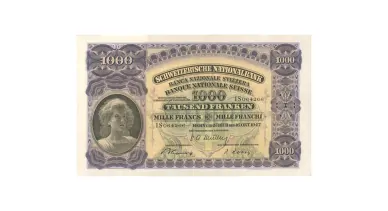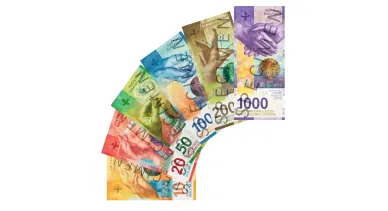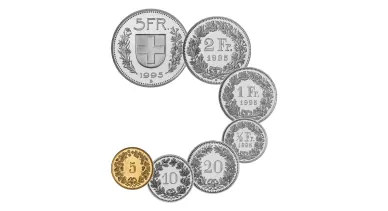The Swiss Franc

The Swiss Franc (CHF, Fr) is the legal tender of the Swiss Confederation, Liechtenstein, the Italian comune Campione d’Italia, and the German city of Buesingen am Hochrhein. It is considered one of the most stable currencies in the world.
Though it is the reserve currency, its percent in total currency reserves is not higher than 0.3%.

History
The Swiss franc has been in circulation since 1850. That was the time when the first coins of the independent republic under the name ‘Swiss Confederation’ were minted, and the first banknotes were printed.
At the end of the 18th century, each canton minted its own money exclusively for the needs of the cities and even private premises. When France established the Helvetic Republic on the Swiss territory as an ally, the franc appeared as the single currency.
The French gave it the name ‘franc de Suisse’ - ‘the Swiss franc’ that has remained forever. The cantons decided to keep the single currency even after the Helvetic Republic was abolished and to peg it to the French franc with the rate of 1.5:1.
Switzerland joined the Latin Monetary Union together with France, Belgium, Italy, and Greece. Therefore, the currencies of those countries penetrated the Swiss financial sphere and obtained the right to free circulation. However, the Union dissolved in the 1920s.
In 1929, a global economic crisis took place and lead to the collapse of monetary systems in many countries. Switzerland suffered too: the national currency fell by 30%. Nonetheless, that was the only big depreciation of the Swiss franc in its history.
Between 1945 and 1973, the currency was pegged to the US dollar during the functioning of the Bretton Woods system with the exchange rate of 4.305 Fr:1 USD and 4.375:1. When the system ceased to exist, the dollar rate dropped to less than 1 franc for 1 USD. The euro rate is 1 Fr:0.91 EUR.
At present, despite active cooperation with the European Union, the Confederation does not introduce the euro within its territory and continues using the Swiss franc. In this way, the country maintains its fiscal independence.
Design
The Swiss national currency is issued by the National Bank and the Swissmint. Nine series of banknotes have been released: 1907, 1911-1914, 1938, 1954-1961, 1976-1979, 1983-1985, 1994-1998, 2016-2019.

Banknote of 1000 francs - second series of banknotes (1911)
Since May 1, 2021, the ninth series notes have become the only legal tender. Paper money from the previous series will be limited in circulation till the end of October this year.
- 10 Fr is a yellow banknote that measures 123 mm by 70 mm. Its obverse features the conductor’s hands, a clock, and time zone borders on the globe. The watch’s movement in the background of the railway tunnel is depicted on the reverse.
- 20 Fr is a red banknote that measures 130 mm by 70 mm. It features a geometrical pattern, a prism in a hand, and a star constellation on the obverse and butterflies, a movie screen, and a stage on the reverse.
- 50 Fr is a green banknote that measures 137 mm by 70 mm. It features a hand holding a dandelion and a globe with a direction of winds around it on the obverse.
- 100 Fr is a blue banknote that measures 144 mm by 70 mm. Its obverse features a pair of hands that are holding water. The reverse depicts a river in the Valais mountains.
- 200 Fr is a banknote of various shades of brown. It measures 151 mm by 70 mm. The obverse contains the image of a globe and right-hand fingers pointed in different directions. The reverse depicts the particle collision map.
- 1000 Fr is a purple-orange banknote that measures 158 mm by 70 mm. It features the shaking hands and the globe on the obverse and the Swiss Parliament hall on the reverse.

Samples of Swiss franc banknotes
The Swiss coins are minted in seven denominations: fractional coins from 5 to 20 rappen and from 0,5 to 5 francs. One- and two-rappen coins were minted earlier but were withdrawn from circulation in 2006 and 1974 respectively.
A rappen is a fractional coin of Switzerland and has four name variations according to the four official languages. German-speaking population calls it rappen, French-speaking people - centime, the Italian Swiss - centesimo, and the Romansh - rap. One franc is divided into 100 rappen.
The obverses of all coins, apart from the five-franc coin, feature the laurel crown and the denomination in the centre. The coin of five francs features the Swiss coat of arms in the middle surrounded by the laurel branches and the denomination in the upper part. The reverse depicts Helvetia that has remained the symbol of Switzerland for 150 years.

Swiss franc coins
The banknote design used to change all the time, but the coins have kept the same size and images since 1850. The only thing that has changed is the alloy. Rappen and franc coins consisted of silver till the 1960s and then comprised cupronickel. Later, the alloy was changed to copper and nickel. Now the five-franc coins are produced of the alloy of copper, nickel, and aluminum.
From time to time, there are releases of commemorative coins in denominations of 10, 20, and 50 francs dedicated to various anniversaries. The coins may be bimetallic and monometallic. In 2004 and 2007, the coins of 50 and 20 francs were minted in gold-copper and silver-copper alloys.

The Swiss Franc in the World
The currency of the Swiss Confederation has zero inflation and thus is considered one of the most reliable in the world. So it is often used in prize pools of prestigious sports competitions. What is more, the headquarters of the majority of international sports organisations are located in Switzerland.
FAQ
When did Swiss francs appear?
The Swiss franc was introduced in 1850.
Why is Swiss currency called CHF?
"CHF" stands for "Confoederatio Helvetica Franc," with "Confoederatio Helvetica" being the Latin name for the Swiss Confederation.
Which country uses CHF currency?
Switzerland and the Principality of Liechtenstein use the CHF currency.
What is the symbol and code for Swiss franc?
The symbol for the Swiss franc is "Fr." or "SFr." and the code is "CHF."
What are the denominations of Swiss francs?
Swiss franc banknotes come in denominations of 10, 20, 50, 100, 200, and 1,000 francs. Coins are denominated as 5, 10, 20, and 50 centimes (or rappen in German), and 1, 2, and 5 francs.
What is depicted on Swiss francs?
Swiss franc banknotes feature various notable Swiss personalities from the world of culture. The designs and people depicted can change over time with new series of banknotes. Coins typically feature the Swiss cross and other national symbols.
Why is CHF so strong?
The CHF is strong due to a combination of factors, including Switzerland's stable political system, robust economy, prudent fiscal policies, strong banking system, and its traditional role as a safe-haven currency during times of global economic uncertainty.







